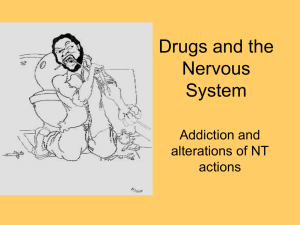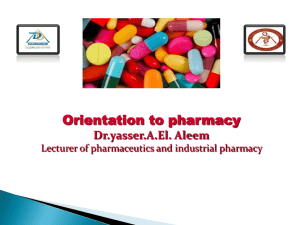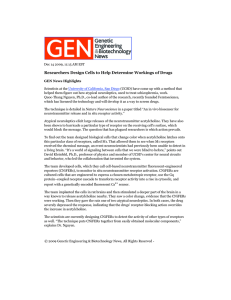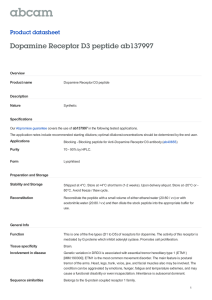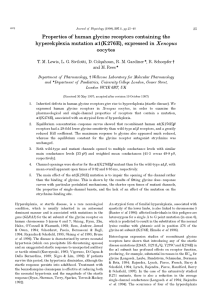J. H. Steinbach 2007;581;3-; originally published online Mar 22, 2007; DOI: 10.1113/jphysiol.2007.131367
advertisement
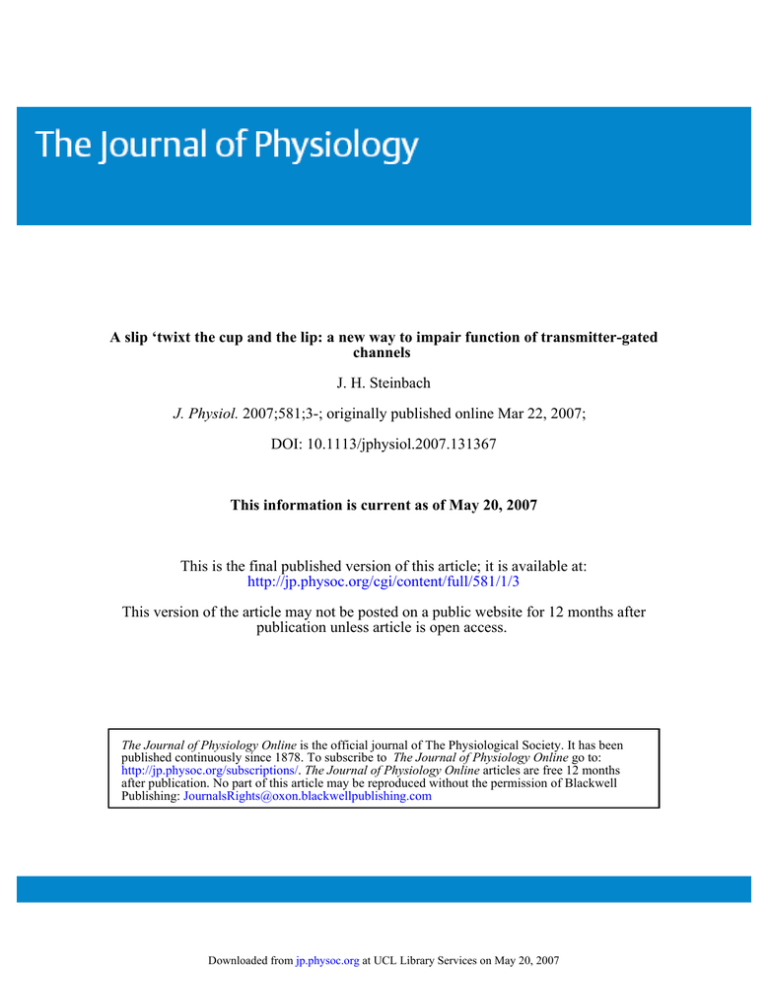
A slip ‘twixt the cup and the lip: a new way to impair function of transmitter-gated channels J. H. Steinbach J. Physiol. 2007;581;3-; originally published online Mar 22, 2007; DOI: 10.1113/jphysiol.2007.131367 This information is current as of May 20, 2007 This is the final published version of this article; it is available at: http://jp.physoc.org/cgi/content/full/581/1/3 This version of the article may not be posted on a public website for 12 months after publication unless article is open access. The Journal of Physiology Online is the official journal of The Physiological Society. It has been published continuously since 1878. To subscribe to The Journal of Physiology Online go to: http://jp.physoc.org/subscriptions/. The Journal of Physiology Online articles are free 12 months after publication. No part of this article may be reproduced without the permission of Blackwell Publishing: JournalsRights@oxon.blackwellpublishing.com Downloaded from jp.physoc.org at UCL Library Services on May 20, 2007 3 J Physiol 581.1 (2007) p 3 PERSPECTIVES A slip ’twixt the cup and the lip: a new way to impair function of transmitter-gated channels J. H. Steinbach Department of Anaesthesiology, Washington University, Campus Box 8054, 660 South Euclid Ave., St Louis, MO 63110, USA Email: jhs@morpheus.wustl.edu The glycine-gated receptor is a member of the nicotinic receptor family, often overshadowed by its cousins the nicotinic, GABA-ergic and even serotonin type 3 receptors. Glycine receptors are found in many regions of the nervous system (Lynch, 2004), but are best known as the targets for the convulsant poison strychnine. By blocking glycine receptors in the spinal cord, strychnine produces tonic paralysis. In humans and laboratory animals, the major feature of deficient glycine receptor expression or function is an exaggerated response to sudden stimuli, or excessive tone in muscles. One of the spontaneous mutations identified in mouse is named spasmodic, which produces tremor, exaggerated startle and some gait abnormalities. This results from a missense mutation in the glycine receptor α1 subunit, A52S. Spasmodic is a loss-of-function mutation, and results in a shift in the concentration–response relationship to larger concentrations of glycine and a more rapid decay of responses (Graham et al. 2006). In an article in this issue of The Journal of Physiology, Plested et al. (2007) explore in elegant kinetic detail the functional deficit produced by this mutation, resulting in a very interesting insight into the repertoire of mechanisms for reduction of receptor activation. Earlier work from this group examined wild-type glycine receptors (Burzomato C et al. 2004), and provided strong evidence for a particular activation scheme (Scheme 1). In this scheme, a receptor has three states: resting (C), ‘flipped’ (F) and open channel (O). In each case, up to three glycine (A) molecules may bind to a receptor. The flipped state has a closed channel, and is interposed between the resting receptor (top row) and the open channel form (bottom row). Channel gating steps occur between the middle and bottom rows. The scheme is based on the ‘concerted transition’ or MWC allosteric model, and relies on the idea that the receptor as a whole undergoes a transition from C to F. The binding sites have identical microscopic affinities for glycine, while the affinity for sites of receptors in the F state is higher than in the C state. Plested et al. (2007) demonstrate that the functional abnormality in the spasmodic receptor is a consequence of an effect on the closed channel isomerization from Ai C to Ai F. The effect can be stated in two ways. First, in the spasmodic receptor the equilibrium ratio of Ai F to Ai C changes very little between singly and triply liganded receptors (only ∼3-fold, versus 5000-fold for wild-type receptors). Second, the affinity for glycine in the flipped state is reduced in the spasmodic receptor (to ∼800 μm from ∼8 μm), and the affinity in the flipped state is only ∼2-fold better than in the resting state, as compared to ∼65-fold. The predicted activation curve is shifted to higher concentrations of glycine, as observed. When miniature inhibitory postsynaptic currents are simulated they are predicted to decay more rapidly, also as observed. A possible reason for the more rapid decay is that the rate for moving from A3 F to A3 C is increased ∼6-fold while the channel opening rate from A3 F is reduced ∼2-fold in the spasmodic receptor. Finally, the spasmodic receptor also shows less change in apparent glycine affinity as a function of occupancy (less apparent cooperativity in binding). Burzomato et al. (2004) argued that the existence of the flipped conformation provides a plausible explanation for the observed apparent cooperativity: the concerted conformational change allows (un)occupied sites to sense the occupancy of relatively distant sites. Accordingly, the deficit in the flipped conformation provides a simple and elegant explanation for the reduced cooperativity. So, receptor function can be compromised (and possibly enhanced?) not only by effects on resting or open channel receptors, but by an action on an intervening state. The duration of the closed dwells associated with the flipped conformation appears to be longer for the glycine receptor than for other family members, but it seems plausible that analogous states are present for other receptors. Indeed, an interposed closed channel transition in the activation pathway has been postulated for NMDA (Banke & Traynelis, 2003) and GABAA (Lema & Auerbach, 2006) receptors. Hence, this mechanism may not only be new, but may prove applicable to additional situations. References Banke TG & Traynelis SF (2003). Nat Neurosci 6, 144–152. Burzomato V, Beato M, Groot-Kormelink PJ, Colquhoun D & Sivilotti LG (2004). J Neurosci 24, 10924–10940. Graham BA, Schofield PR, Sah P, Margrie TW & Callister RJ (2006). J Neurosci 26, 4880–4890. Lema GM & Auerbach A (2006). J Physiol 572, 183–200. Lynch JW (2004). Physiol Rev 84, 1051–1095. Plested, Groot-Kormelink, Colquhoun & Sivilotti (2007). J Physiol 581, 51–73. AC A2C A3C CLOSED AF A2F A 3F FLIPPED AO A2O A3O OPEN Scheme 1 C 2007 The Author. Journal compilation C 2007 The Physiological Society Downloaded from jp.physoc.org at UCL Library Services on May 20, 2007 DOI: 10.1113/jphysiol.2007.131367 A slip ‘twixt the cup and the lip: a new way to impair function of transmitter-gated channels J. H. Steinbach J. Physiol. 2007;581;3-; originally published online Mar 22, 2007; DOI: 10.1113/jphysiol.2007.131367 This information is current as of May 20, 2007 Updated Information & Services including high-resolution figures, can be found at: http://jp.physoc.org/cgi/content/full/581/1/3 Subspecialty Collections This article, along with others on similar topics, appears in the following collection(s): Perspectives http://jp.physoc.org/cgi/collection/perspectives Permissions & Licensing Information about reproducing this article in parts (figures, tables) or in its entirety can be found online at: http://jp.physoc.org/misc/Permissions.shtml Reprints Information about ordering reprints can be found online: http://jp.physoc.org/misc/reprints.shtml Downloaded from jp.physoc.org at UCL Library Services on May 20, 2007



